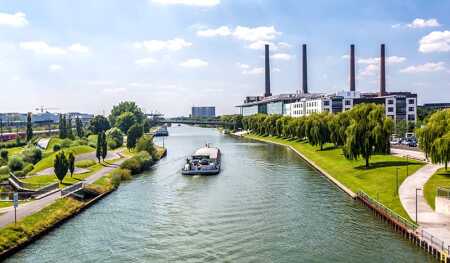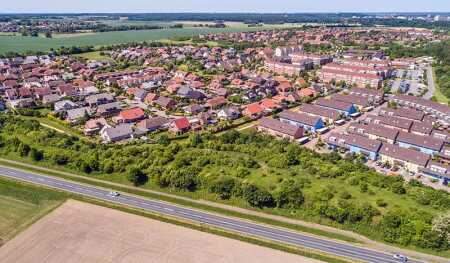This article appeared in the winter issue of Urban Land on page 66.
The city of Wolfsburg, known internationally as the headquarters of car manufacturer Volkswagen and the VFL Wolfsburg soccer team, which plays at Volkswagen Arena, is unique in both urban planning structure and demographics in Germany. As one of the nation’s newest cities, Wolfsburg was built, was developed, and grew throughout a period when the car was the predominant means of transport. While other German cities never went fully into motorized individual vehicle optimization, since the existing cores dated back to pre-car times, making major changes difficult, Wolfsburg was planned and built with powerful road networks in mind. But today, young professionals, urgently needed by Volkswagen, often expect something less car-centric from their urban surroundings.
Wolfsburg AG, a company founded and owned by both Volkswagen AG and the city of Wolfsburg to manage projects that make the city more attractive, commissioned the ULI Advisory Services panel to get fresh advice on ways to increase the city’s competitiveness. The panel consisted of Chairman Professor Jürgen Bruns-Berentelg, chief executive officer, HafenCity Hamburg GmbH; and members Paul Bernard, ULI Americas executive vice president of Advisory Services; Christopher Choa, vice president and director of cities, AECOM; Chris Igwe, founder, Chris Igwe International; Tom Murphy, ULI senior resident fellow, Canizaro/Klingbeil Chair for Urban Development, and former mayor of Pittsburgh; Christiane Thalgott, former head of the Urban Planning and Building Department in Munich; Lisette van Doorn, CEO of ULI Europe; Birgit Werner, vice president, property development, Flughafen München GmbH; and Michaela Winter-Taylor, senior associate, Gensler.
“The creation of Wolfsburg was driven by the aim to redevelop the German economy, create jobs, and build modern infrastructure. An entire city has risen from the ambition to produce cars for the masses in an unlikely location chosen for the ease of distribution. There is rarely another city whose past is so closely linked to one company. Together, their future depends on a shared vision to evolve jobs and infrastructure in response to the disruptive effects of technological advances,” said Winter-Taylor.
After site tours and interviews with local stakeholders in Wolfsburg, panelists started to understand the essence of this special town. The relatively small city south of the Mittelland Canal, accommodating one of the biggest car factories in the world on the canal’s north bank, seems almost divided into two different realms. To emphasize the reunification of city and factory, the panel chose “Better Together” as its theme in approaching these challenges.
Wolfsburg is doing well now, but the challenges it will face in a not-so-distant future can already be anticipated. The challenges are tied to the creation of an environment capable of fulfilling the future urban needs of young professionals—the workforce that an ever-evolving Volkswagen factory needs. Bruns-Berentelg summarized the challenge this way: “How can Wolfsburg create the greatest value, for the greatest number of people, with the least cost, in the shortest amount of time?” A city is a complex thing, and often the plan of action for those trying to revitalize a city is not obviously defined, so the panelists decided to define five statements by which to structure their goals.
Value the Gap
The Mittelland Canal is the main body of water in the city. It functions, together with the high-speed train tracks south of the canal, as a barrier between the city of Wolfsburg to the south and the Volkswagen plant to the north. The location of the train tracks limits accessibility of the southern promenade. Also, the factory area, including the north bank of the canal, is closed off. The panel suggests opening the northern promenade to the public, so the division the canal now creates is converted into an embrace of the waterway as a valuable element of urban life. The city and Volkswagen not only must intermingle on a work basis, but also must visibly grow together as one entity, panelists concluded.
The Mittelland Canal is the main body of water in the city. It functions, together with the high-speed train tracks south of the canal, as a barrier between the city of Wolfsburg to the south and the Volkswagen plant.
Develop the Core
The inner city of Wolfsburg is divided into two sections—Nordkopf, a spacious area between the train station, the canal, and the northern tip of Porschestraße; and Porschestraße itself, a High Street that leads southbound from Nordkopf. Both show very different characteristics in development. The panel suggests that the Nordkopf area should be converted into the city’s lively urban core by emphasizing mixed-use developments and the creation of innovative jobs. Porschestraße should instead keep its local character, with many regional dealerships and traditional shops, but it can be significantly improved by landscaping the public spaces.
Link to Nature
Wolfsburg is a healthy city. The panel emphasizes that the urban structure of Wolfsburg offers great potential for large, open, and natural spaces that are attractive to residents. And the notion of urban green space is gaining importance. “As the climate changes, our landscapes have to be valued,” said Thalgott. The panelists suggest that the city make good use of nature and integrate it into the city’s urban structure as usable, green leisure areas, which could become a selling point for Wolfsburg. Furthermore, they note that, given the issues presented by disparity between the city’s quarters, it is important that the challenges presented by this urban structure be met. “Give the residents an emotional boost from a secure and interactive environment and connect the widespread housing areas and communities in the region with new mobility concepts,” said Thalgott.
Future Mobility
Automotive mobility is facing great changes in the near future. Disrupters like e-mobility, autonomous driving, and car sharing are just a few of the challenges. The panel identified Wolfsburg as a potential laboratory for future mobility concepts. Because of its unique urban structure and the availability of knowledge from Volkswagen, the city offers the opportunity to try out new concepts in a real environment. This development can also be used as a global showcase for mobility best practices.
Pioneer Wolfsburg
Panelists said that the city’s pioneering spirit should apply to future projects. The cooperative approach between the city and Volkswagen should be intensified and shows great potential. Volkswagen should keep pushing to be the industry leader in technology, production, and innovative mobility concepts, and these concepts should continuously be tested in Wolfsburg. And, by creating a strong master plan, the city of Wolfsburg can position itself as a hub for innovation and a draw for knowledge-based communities.
Manfred Günterberg, board member of Wolfsburg AG, said, “It was a great honor and pleasure to have such a team of international experts in Wolfsburg. The results were awesome and absolutely helpful for the decision makers in Wolfsburg. [The Advisory Services panel] was and still is a great opportunity to make the city of Wolfsburg more attractive as a place to live and work. Especially in Wolfsburg, a parallel development of mobility, leisure, living, and infrastructure is important—coordinated with the city of Wolfsburg and Volkswagen. The unprejudiced view of the experts was an important impulse for future development.”








